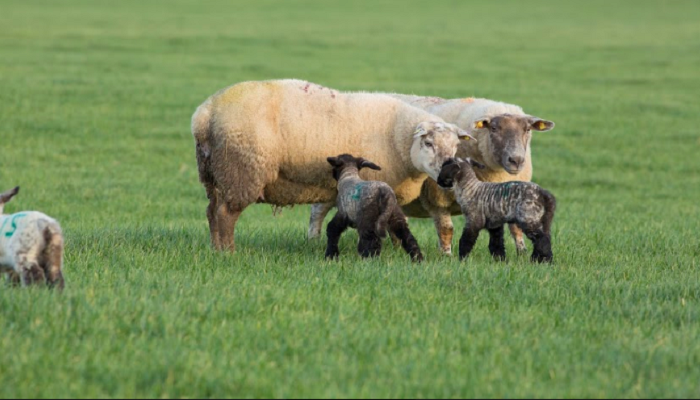25 March 2025
Grass tetany control in ewes

Damian Costello, Sheep Specialist at Teagasc, tells us why it is really important to have a grass tetany control programme in place, sharing tips on its control and high risk conditions.
A welcome sight in recent weeks is ewes and young lambs being turned out to grass. It is really important to have a control plan in place when lactating ewes go to grass to prevent Hypomagnesaemia or grass tetany as it is more commonly known. The disease is caused by low magnesium (Mg) levels in the blood and, if not detected early and treated promptly, it is frequently fatal. It is therefore best to put prevention measures in place early before you are presented with a clinical case of the condition.
Conditions where grass tetany is high risk
Some farms appear to be higher risk for ewes developing grass tetany than others. This is somewhat explained by the main factors likely to trigger the condition which include:
- Poor weather, in particular high rainfall periods, has a negative impact on both the utilisation and intake of available grass as well as a reduced capacity of the ewe to take up nutrients from the grass. Furthermore, inclement weather conditions often leads to ewes seeking shelter for lambs at times they would normally be grazing.
- The level of Mg potentially absorbed from forage is reduced in swards containing rapidly growing lush grass. Take care with fields recently reseeded along with areas receiving high levels of nitrogen (N) fertiliser and in particular high spring applications of potash (K).
- Factors that cause stress to ewes including weather conditions, any underlying health issues, poor nutrition etc. – peak lactation (4 to 6 weeks post lambing) is a time when under stress ewes are particularly vulnerable but animals do succumb to the disease outside this window also.
Symptoms and treatment
In many cases the first symptom can be a dead ewe, but affected sheep that are still alive will be observed twitching, staggering or as the condition progresses lying on the ground kicking. Treatment involves administering a subcutaneous injection of 100ml of a 25% magnesium sulphate solution as quickly as possible. For optimum absorption, the solution should be delivered at body temperature splitting treatment across 5 to 6 different sites on the ewe’s body. Success is dependent on the condition not having progressed too far before being treated.
Control plan
Sheep have no capacity to store magnesium in their body meaning they need to ingest a continuous supply of the element. There are some reserves in the skeletal structure but it is not readily mobilised and will contribute little or nothing in terms of the ewe’s daily requirements. In terms of management, spring applications of potash (K) fertiliser should not exceed 70kgs per hectare on ground intended for grazing with ewes and lambs taking account of slurry applications as well as K contained in bag fertiliser. It is possible, but often somewhat impractical, to try to avoid grazing swards containing fast growing grass during high risk periods.
In terms of requirement, the lactating ewe needs 1-2g of magnesium daily. However taking account of the fact that during adverse weather and times of stress, the ewe’s ability to absorb magnesium into the bloodstream can be halved, the recommended rate of supplementation for ewes is 3 – 5g per head per day.
The following are the main options to provide this:
- Supplementary feeding ewes at grass with a sheep ration or nut containing calcined magnesite (Cal Mag) is the surest way of getting magnesium into all ewes, However, where there is an adequate grass supply ahead of the flock it doesn’t make economic sense.
- The normal inclusion rate is 1% or 10kg Cal Mag per ton of feed. Always ensure that rams are not fed concentrates containing Cal Mag due to the risk of them developing urinary calculi.
- High Magnesium lick buckets, usually containing either 10% or 15% Mg, are convenient where ewes are on a grass only diet post turnout.
- There are of course the ewes that will not consume their daily requirement so there are no guarantees.
- Use a product specific to sheep as the cattle version may contain levels of copper which would be unsafe for sheep. Dual purpose buckets, suitable for bovines and ovines, are available and are useful where co-grazing is taking place.
- It is important that there is free access to buckets or licks – generally 3 to 4 per grazing group should be provided, keeping a check that they don’t run out.
- On farms known as high risk for grass tetany, feeding 0.5kg concentrates per ewe per day for 1- 2 days prior to and for the few days of adverse weather conditions can complement lick buckets and further safeguard the flock.
- There are bolus options to supply magnesium – important to follow manufacturer’s instructions as many require a further treatment after 30 days. On farms very prone to grass tetany the bolus alone may not be capable of meeting the ewe’s daily requirement for magnesium.
- Top dressing of pasture using the powder form of Cal Mag at the rate of 17kg/ha weekly is not widely practised on sheep farms here. A grass cover of 10cm, ideally with moist conditions, is needed at time of application to stick magnesium dust onto grass leaves.
- Although it may have a place for cows, adding magnesium to the water supply is not a success with sheep – in times of high rainfall which are deemed high risk for the onset of the condition, sheep will gain most of their water requirements from grazing wet grass and are unlikely to bother with the water troughs at all.
